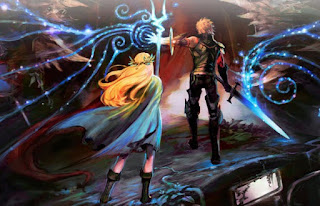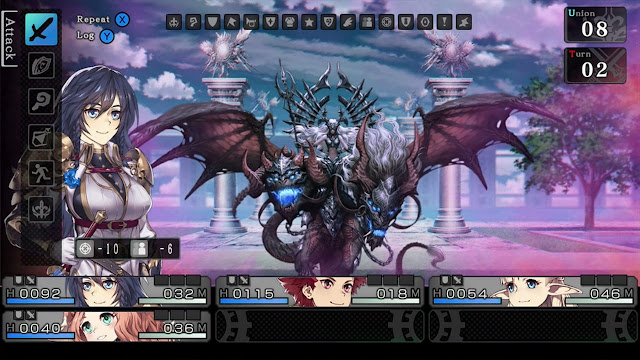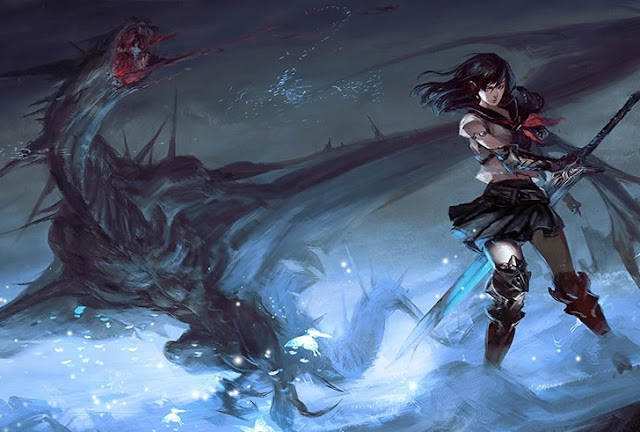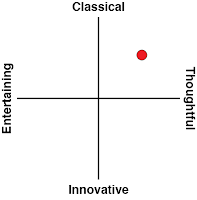It did seem for a while there that the first person dungeon-crawlers might become a dead genre, but the quality of Wizardry-likes has captured imaginations anew and for the last decade or so the genre has been enjoying a real renaissance for anyone willing to take a deeper look. One of those modern treasures was Experience Inc’s Entaku no Seito or Students of Round. First released back in 2011, it has now been remade as the companion to the rather excellent Stranger of Sword City. Packed together in one convenient bundle on the Nintendo Switch, these two games will provide 40+ hours of dungeon-crawling goodness, each. Compared to the retro heavy hitters of the genre (thinking about Wizardry, Shining in the Darkness or the early Shin Megami Tensei games), both Saviors of Sapphire Wings and Stranger of Sword City are among the most user-friendly crawlers on the market, with Sapphire Wings being a prime entry point to the genre for modern players. This review will mostly cover Sapphire Wings, since we’ve already had plenty of positive things to say about Stranger of Sword City when it first came around on the Vita and Xbox 360.
If you’ve never played a dungeon crawler before, that’s good because it’s one of the easiest RPG subgenres to explain and define. Players build a party of heroes, each with their own classes and special skills, and roam down first-person dungeons which are filled with random encounters. There’s a greater emphasis on traversal and party building in crawlers compared to top-down JRPG’s, since dungeons will be filled with things like traps and hidden passageways, and battles tend to be designed to wear down your squad with attrition, forcing you to constantly backtrack and then try again to inch forward a little more on the next “run”. The upside is that this added difficulty affords a tremendous sense of growth and achievement. You’ll finish the game with a party that is well and truly yours, having braved your way through large and expansive dungeon halls and pillaged them for all that they’re worth.
Saviors of Sapphire Wings fits these genre trappings snugly. The graphics and mechanics will be familiar to anyone who’s played a dungeon crawler before, but Sapphire Wings is more forgiving to the new player. The game has a better-structured narrative compared to other party-builders like even Stranger of Sword City, and the player gets new party members trickled to them rather than having to make difficult decisions about the entire group’s construction from the onset. Character classes can be re-specialised with little consequence, and there’s also no permadeath. There is still a dearth of gold and equipment, particularly in the early game, but for the patient player it’s not hard to dive into the dungeons and start making progress.
The premise is that before the narrative began, some vaguely Arthurian heroes tried to fight an eldritch abomination named Ol=Ohma (yep its name has an equals sign in it, just roll with it) but failed at the last minute. The heroes were ostensibly killed, and one wakes up in a reincarnated form 100 years later to find a world slowly being corrupted by Ol=Ohma’s dark influence. You see, the antagonist’s power in this game is to corrupt the minds of individuals and turn them against their allies. With vague recollections of his past failure, Xeth, our hero, must gather a new bunch of prophesied “Squires” to take on Ol=Ohma and save the world from evil.
It’s not the most inspired story but it’s a great deal more narrative and world-building than most would expect from a dungeon crawler. The focus on creating strong character bonds means that players will often be talking to their party members, understanding their insecurities, and forging friendships that will eventually be strong enough to resist Ol=Ohma’s mind powers. This is all systemised in a relationship-values plot. As party members defeat enemies, or eat meals with the hero, they’ll increase heart values – and once the hero talks to them when they’re at 100 per cent, they’ll go up a Soul Level, like in Persona’s relationship systems. By increasing Soul Levels, the player will unlock whole-party skills which add further strategy to combat.
Experience Inc’s remaster of Entaku no Seito comes with an excellent translation which really lets the characters shine in their dialogue sequences. One of my favourite characters is Lumi, a princess who realises that she is destined to be a Squire in service of Xeth. She starts off as the stubborn, stuck-up stereotype, but the dynamic is fascinating because she’s desperately trying to fight against this impulse, since she knows that she’ll need to respect Xeth if her quest is to succeed. Each of the game’s characters has a nuanced insecurity along these lines, and it’s hinted that these insecurities are the very things that give Ol=Ohma the ability to mind-control its vassals. If you’ve always wanted a dungeon crawler to take its characters more seriously, then I can’t recommend this game enough.
An interesting change made between the original Entaku no Seito and Saviors of Sapphire Wings is an overall re-alignment of the original game’s structure, to better mirror the structure of Stranger of Sword City. Whereas in Entaku no Seito characters were restricted to one class and could unlock a subclass after becoming friendly enough with the hero, Saviors of Sapphire Wings allows the player to pick the character’s class on a whim. The classes themselves – Fighter, Paladin, Samurai, Wizard, Healer, Alchemist, Druid and Ranger – are also aligned with the classes in Sword City. It’s important to have diversity in classes since you’ll be bringing six characters at once into a dungeon, and each class has a mix of offensive, defensive and overworld skills which are crucial for success.
I thought that character customisation was still unfortunately a bit lacking here. The main problem is that there’s no skill tree, and instead characters learn abilities solely through level-up. Players also only get a single skill point to spend, with every level. This means that some classes feel shallow – particularly Samurai, which gets some attacking techniques but is mostly built around strong basic attacks: there’s no need to bother with Intelligence for this class. There’s a solid elemental system for the Wizard, but ultimately everything but the postgame is beatable with just beefy characters and good gear. This isn’t a huge problem, since getting the good gear itself is challenging enough, but I do think that players expecting more customisation options might find the game lacking.
Gear is doled out in a similar way to Stranger of Sword City. Money is extremely scarce in this game, barely dropping from enemy encounters and instead needing to be scrounged by selling vendor trash the monsters randomly drop. Shops are well stocked with good equipment, but buying them will take forever. Instead, loot is better obtained from “Trap Points” – certain areas in the dungeon where the player can leave a food item as bait, fight a strong monster, and then open a treasure chest that they’re guarding. (The reason why travelling monsters carry treasure chests with them is explained in Stranger of Sword City, because the player is ambushing supply trains in that game, but in Sapphire Wings it makes no sense whatsoever). Better loot attracts stronger monsters, so it’s possible to make the party extremely overpowered early on if the player alchemises some good food and has the strategy to take on late-game enemies.
Strangely enough, these trap points also factor into the narrative; often the story won’t advance until the player defeats enemies at each trap point in a zone. This works to ensure characters are continually getting stronger, but you can really feel the narrative contriving itself around this mechanic, and this often robs the narrative of any sense of urgency.
Unfortunately too, loot gained from Trap Points is randomised – players won’t even know what item they’ve received until after they go back to their home base, and it becomes automatically identified. Often you’ll receive equipment that isn’t relevant for your current character classes, or is a strict downgrade from what you’ve already got. At other times you’ll hit the jackpot and get something several times more effective than what you’ve got. Each character has six equipment slots, so there’s some micromanagement to be done. And if getting loot sounds like gatcha to you, then you’ll especially love the mechanic where unwanted equipment can be melted down in a furnace to eventually give an inexplicable +1 buff to future drops you find. (My suggestion is to avoid this in the early game and just sell the loot you don’t want, and simply buy the equipment you need from the store instead of bothering with the randomness of Trap Zones.)
Once you’ve decked out your characters with area-equivalent weapons and armour, there’s still a great deal of strategy to be had in combat itself. These are huge affairs with six party members and lots of enemies. Buffs, debuffs and status conditions can be useful if players want to micromanage but, aligning with the game’s quality-of-life updates, Sapphire Wings has lightning-fast replay-turn and quick-fight system, which lets players execute an entire round of combat in mere seconds. This means that players who want to explore the game’s depth can do so (and will likely preference the more versatile classes like Alchemist and Druid) but for those who just want to grind and use basic attacks, a party of Fighters, Rangers and Healers can get through the plot just as effectively, and sometimes even faster.
Outside of the dungeon’s players can synthesise food items – for use as bait or boosting relationship values – through an alchemy menu. It’s very simplified: items can either be morphed into something else on a 1:1 ratio (1 Monster Meat becomes 1 Baked Meat, for example), or can be improved in a 3:1 ratio (3 Coarse Flour becomes 1 White Flour). There are no recipes to follow, no combining items like in Atelier, only this simple system of equivalent exchange. Like with melting down excess armour, there’s lots of menu-ing to be done outside of dungeons to stay relevant, but alchemy does start becoming important as the player is forced to use better quality loot to complete their Trap Zones.
All and all it means the game is time-consuming, which I imagine genre aficionados will enjoy. There’s plenty of dungeons to explore, enormous and gorgeous bosses to fight, and one of the most generous post-games I’ve ever seen. The overall difficulty does skew on the easy side, even in Normal mode – while I did get my party wiped a few times, it’s nothing that a few levels won’t fix. For this reason I highly suggest completing Sapphire Wings before Stranger of Sword City. Despite the naming conventions, the games are barely connected aside from some common monster designs. Stranger of Sword City is the much more unforgiving game, with permadeath, more traps in dungeons, and combat which more greatly rewards strategic planning.
In terms of production values, the remaster does a lot of good for Saviors of Sapphire Wings. Character portraits are well done and the player gets a choice between the classic Entaku no Seito designs, and a few modern choices too. The enemy designs look incredible and I particularly love the bosses which take up the entire screen with their wonderfully detailed art. It’s a shame that there are no animations however – I felt that this did take away from the uniqueness of the encounters. And the dungeons… well, they’re what you’d expect from the genre – bland but perfectly serviceable.
– Harvard L.













